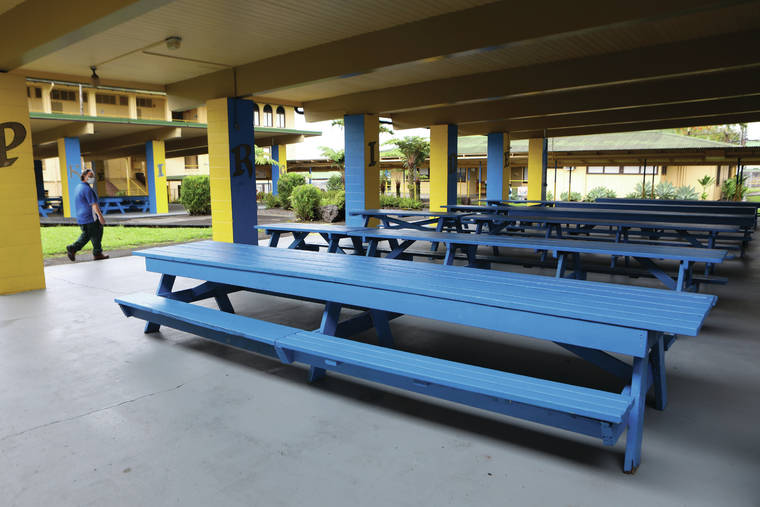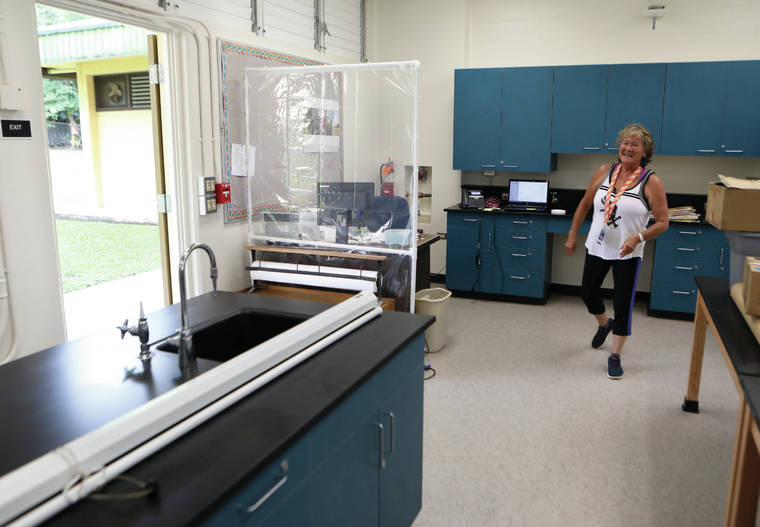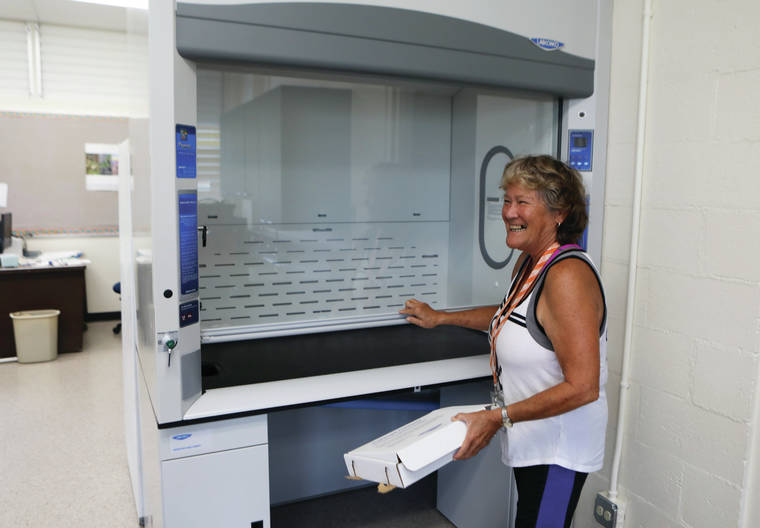Officials finalize in-person learning plans

Vice principal Jason Trimble walks past the freshly painted lunch tables at Hilo High School on Friday. (Kelsey Walling/Tribune-Herald)

Kelsey Walling/Tribune-Herald Maud Gooch walks around her new science classroom while preparing for the first day of school at Hilo High School on Friday, July 23, 2021.

Maud Gooch smiles Friday while closing a new machine that will be used when students perform chemical experiments in her new science classroom. (Kelsey Walling/Tribune-Herald)
With less than two weeks until students are set to return to classrooms, state health officials are working to finalize updated safety guidelines for schools and educators are preparing for the new year.
With less than two weeks until students are set to return to classrooms, state health officials are working to finalize updated safety guidelines for schools and educators are preparing for the new year.
“We are carefully planning for school re-openings,” Gov. David Ige said. “The CDC and the state Department of Education see the tremendous value in in-person learning, and we’re committed to reopening all schools in person.”
Because of the ongoing COVID-19 pandemic, DOE schools have not fully reopened to in-person instruction since March 13, 2020.
Outgoing state Superintendent Christina Kishimoto announced in May that public schools in Hawaii would open fully for daily in-person learning. That announcement, however, came before the current surge of COVID-19 cases throughout the state, driven in part by the growing prevalence of the highly transmissible Delta variant.
The state Department of Health currently is revising its school guidance to align with the U.S Centers for Disease Control and Prevention’s updated K-12 guidance released on July 9, and take into account best practices and lessons learned during the 2020-21 academic year, DOH spokesman Brooks Baehr said in an email.
“The Department of Health has been and remains committed to working with the Department of Education to provide a safe in-person learning environment for the 2021-2022 school year,” he said. “Comprehensive planning has gone into strategies for the safe return of students to full in-person learning.”
Hilo-Waiakea Complex Area Superintendent Esther Kanehailua said in an email that preparations for in-person learning have been the focus for schools. Safety and COVID protocols have been prepared and in place for quite some time, she said.
“I think all the planning and preparation still has to be tested once everyone is back on campus, and because of that, there is a mix naturally of excitement and anxiousness.”
Although the DOE this week published a list of schools that will offer distance learning options to students, department spokeswoman Nanea Kalani also said in an email that schools are moving ahead with reopening plans for daily in-person learning as the DOE awaits the updated health and safety guidance.
“The Department is focused and committed to safely welcoming students back for daily in-person learning,” Kalani said. “Hawaii public schools have proven to be safe spaces throughout the pandemic. Despite more than 1,000 cases reported by schools and offices since June 2020, consistent adherence to safety protocols has meant that there has been very limited transmission of the virus at DOE facilities.”
The wide availability of vaccines also has added a layer of protection, she said.
Kalani said since May, the DOE has hosted more than 100 school-based vaccination clinics statewide to make vaccines available to students and families ahead of the new academic year.
Additionally, during the summer, Kalani said 18 DOE schools are participating in an Increasing Community Access to Testing pilot program with CVS to further contain spread within school communities.
As part of that, 14 schools are doing weekly in-school testing and four schools are providing vouchers for testing at CVS.
Ige, however, expressed concern for children 11 and younger.
“They are the only ones who are not eligible for vaccination. … And a most overwhelming majority, 97% of the new cases that we’re seeing, are in unvaccinated individuals,” the governor said. “I think that’s a concern for all of us in the community. We want to create a healthy and safe environment for our children.
“We do believe that we can, with a layered approach to managing the virus,” he continued. “You know, the department will be implementing a number of mitigation strategies in elementary schools across the state.”
Baehr shared those sentiments and said schools are implementing four core strategies to prevent the spread of COVID-19: promoting vaccination for staff and eligible students, staying home when sick, requiring masks and hand-washing.
“Schools are also layering additional mitigation strategies, including ohana bubbles or cohorting, screening testings, improving ventilation, physical distancing, and cleaning and disinfection, to maintain healthy operations and environments,” he said.
Kanehailua said she, too, worries about the risk to those not yet eligible to be vaccinated, so mask-wearing is important to protect that population, particularly elementary students.
“We already have protocols for when there is a positive and our administrators have been identifying the close contacts and notifying those contacts before there is any formal notification from DOH,” she said. “They are doing what they can as soon as they know to keep their community safe.”
Kalani said COVID-prevention strategies in place for school buses will include masking, a prohibition on eating or drinking, keeping windows open to increase ventilation as well as assigned seating and keeping families seated together when possible.
With COVID-19 cases currently climbing in Hawaii, Kalani said the DOE will continue to implement core mitigation strategies that are effective against the Delta variant and encourages all who are eligible to get vaccinated.
“The more students, teachers, staff and family members that do so will all help to keep our schools safe from COVID-19,” she said. “In the event of a school closure or unexpected emergency, distance learning remains an option.”
According to Kanehailua, any changes to in-person learning will be a discussion between the DOH, the superintendent, deputy superintendents and complex area superintendents.
Addressing learning loss
According to Kalani, a portion of Hawaii’s American Rescue Plan funds for education must be used to mitigate learning loss.
The DOE will present a detailed expenditure plan for the federal coronavirus relief funds to be presented to the Board of Education in August.
Strategies to combat learning loss include returning students to campuses for more in-person instruction, summer programs, specialized student support programs, accelerated personalized learning programs, and on- and off-campus learning opportunities such as internships, career exploration and athletics, Kalani said.
Kanehailua said incoming interim Superintendent Keith Hayashi has “made it clear that the focus on the social emotional learning of our students is critical to the start of a successful year for our students.”
Schools will assess social emotional learning within the first months to begin understanding what students are struggling with as they return to campus, she said, “so that we can support them and create the environments they need to thrive.
“Taking care of student well-being is foundational in being able to improve attendance and address academic needs.”
Reporter John Burnett contributed to this story.
Email Stephanie Salmons at ssalmons@hawaiitribune-herald.com.


